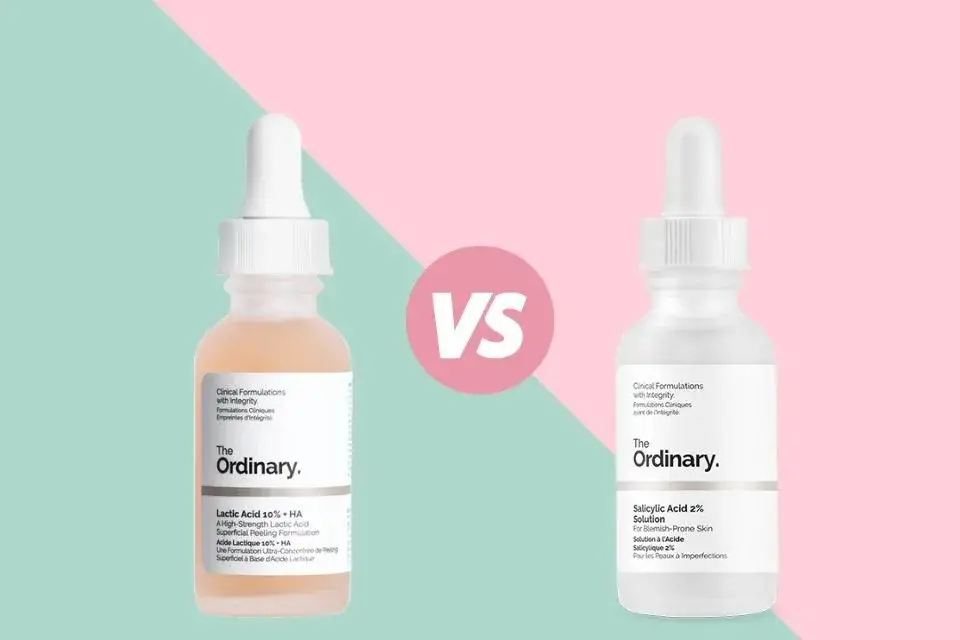
Can I Use a Salicylic Acid Cleanser with Lactic Acid?
If you’ve spent any time exploring skincare, chances are you’ve come across the terms AHA and BHA.
These chemical exfoliants have taken the beauty world by storm, becoming staples in many skincare routines thanks to their powerful yet gentle ability to clear, brighten, and refine the skin.
Among the most popular ingredients in these categories are lactic acid (an AHA) and salicylic acid (a BHA). But a common question arises: Can you use a salicylic acid cleanser together with lactic acid?
Is it safe? Will they work well, or could they cause irritation if combined?
In this post, we’ll break down the science behind these two acids, how they work, and how best to combine them for optimal skin benefits.
What Are AHAs and BHAs?
First, a quick refresher. Both AHAs (Alpha Hydroxy Acids) and BHAs (Beta Hydroxy Acids) exfoliate the skin, but they work differently:
AHAs like lactic acid are water-soluble acids that work primarily on the skin’s surface to gently dissolve dead skin cells, improve texture, and encourage cell turnover.
They’re great for brightening and hydrating, and are especially helpful for dry or sensitive skin.
BHAs, primarily salicylic acid, are oil-soluble, allowing them to penetrate deep into pores to dissolve excess sebum and unclog pores. This makes salicylic acid a favorite for oily and acne-prone skin.
Together, AHAs and BHAs can be a powerful duo, but they need to be used wisely.
What Can You NOT Mix with Lactic Acid?
One of the main rules when using acids like lactic acid is to avoid combining them directly with vitamin C products in the same routine.
Both are acidic and work at a low pH, so layering them can disrupt their effectiveness and potentially irritate the skin.
However, that doesn’t mean you can’t enjoy the benefits of both ingredients.
For example, many skincare enthusiasts apply vitamin C serums in the morning to protect against free radical damage from UV rays and pollution, then use lactic acid products in the evening to exfoliate and refresh the skin.
This separation allows each product to work optimally without compromising skin health.
Should I Use a Cleanser with Salicylic Acid?
The answer here depends largely on your skin type.
If you have oily or blemish-prone skin, a salicylic acid cleanser can be a fantastic addition. Most effective salicylic acid cleansers contain between 0.5% to 2% salicylic acid.
This concentration is strong enough to penetrate deep into pores to dissolve excess oil, dead skin cells, and impurities without being overly harsh.
Because cleansers are rinsed off, they offer a gentle way to introduce salicylic acid into your routine without the risk of prolonged irritation, which sometimes occurs with leave-on treatments.
On the other hand, if you have dry or sensitive skin, you might want to use salicylic acid cleansers sparingly or avoid them altogether to prevent dryness or redness.
Can You Use a Salicylic Acid Cleanser with Lactic Acid?
Yes, but with caution.
For those with dry or sensitive skin, using both salicylic acid and lactic acid in the same routine can be too aggressive. Over-exfoliation may lead to irritation, redness, and a compromised skin barrier.
If you have combination or oily skin, combining these acids can be beneficial for clarity and texture.
Lactic acid, being one of the gentler AHAs, hydrates and exfoliates superficially, while salicylic acid works deeper to keep pores clear.
How to use both safely: Ideally, space their usage by about 15 minutes. This allows your skin’s pH to rebalance between applications, preventing them from neutralizing each other and minimizing irritation risk.
Is It OK to Use Lactic Acid Every Day?
Daily use of high-strength lactic acid products is generally not advised, especially for beginners or those with sensitive skin.
However, lactic acid in lower concentrations, especially in rinse-off formulations like cleansers or exfoliating toners, is usually gentle enough for everyday use without significant irritation.
Still, listen to your skin. If you notice redness, dryness, or flaking, reduce frequency or pause use. Consult a dermatologist if irritation persists.
Is It OK to Use Salicylic Acid Every Day?
Similar to lactic acid, daily use of salicylic acid depends on your skin’s tolerance.
If you’re new to salicylic acid, start by using it 3 times a week to monitor how your skin responds. If there’s no irritation, you can gradually increase usage.
People with oily or acne-prone skin often use salicylic acid daily with success.
However, those with dry or sensitive skin should proceed cautiously and consider consulting a medical professional to avoid over-exfoliation.
Can You Use Lactic Acid Every Night?
Yes, nighttime is actually the best time to use chemical exfoliants like lactic acid.
Why? During sleep, your skin undergoes repair and regeneration.
Applying lactic acid at night helps remove dead skin cells and impurities without interference from environmental aggressors like UV rays and pollution.
Pairing lactic acid with a hydrating serum containing ingredients like hyaluronic acid can boost hydration and strengthen your skin’s barrier.
Can You Apply Lactic Acid on Pimples?
While salicylic acid is generally considered the go-to acid for pimples due to its ability to penetrate and unclog pores, lactic acid can be a good alternative, especially if you have dry but blemish-prone skin.
Lactic acid exfoliates gently and helps remove bacteria and dead skin cells that cause breakouts, without the drying effect often associated with salicylic acid.
How to Build a Routine Using Salicylic Acid and Lactic Acid
Here’s a simple way to include both acids in your routine safely:
Morning:
Cleanse with a gentle, non-acid cleanser
Apply a vitamin C serum (optional)
Moisturize and apply SPF
Evening:
Cleanse with a salicylic acid cleanser (if suitable for your skin)
Wait 15 minutes to allow pH normalization
Apply lactic acid toner or serum
Follow with hydrating serum (e.g., hyaluronic acid)
Moisturize
Adjust frequency based on your skin’s tolerance. For sensitive skin, you might choose to alternate nights—salicylic acid one night, lactic acid the next.
Final Thoughts
Using a salicylic acid cleanser with lactic acid can be effective and safe when done thoughtfully, especially if you have oily or combination skin.
The key is to avoid over-exfoliation, watch your skin’s response closely, and allow time between applications.
If you’re ever unsure or notice irritation, back off and consider consulting a skincare professional.
For more skincare insights and expert advice, be sure to check out our blog and follow us on Instagram for the latest updates, new product launches, and special offers!


